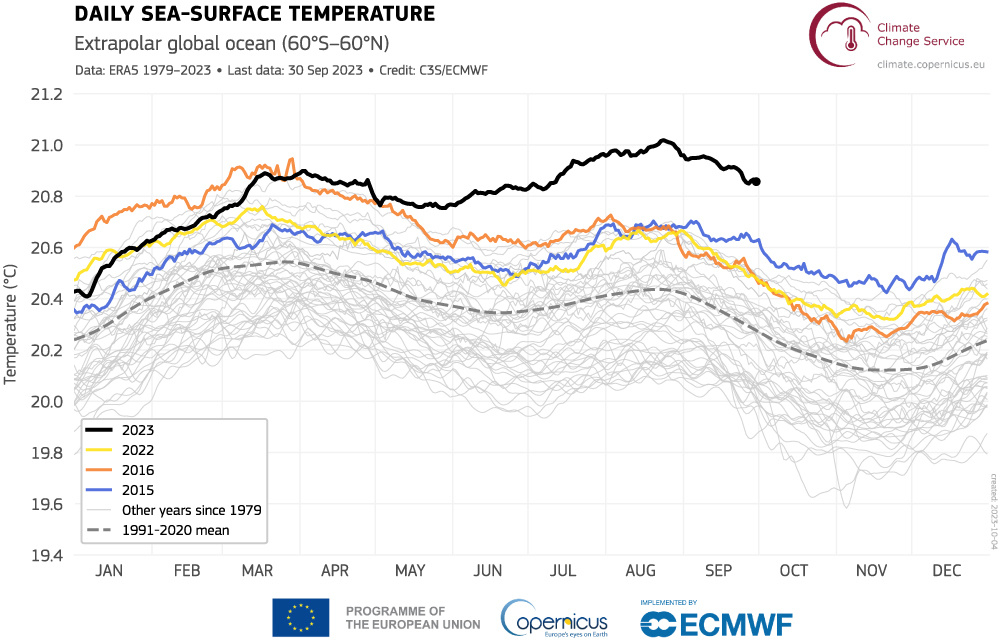The Copernicus Climate Change Service (C3S), implemented by ECMWF on behalf of the European Commission and with funding by the EU, routinely monitors key climate indicators and their evolution. Monitoring data from the ERA5 climate reanalysis over the summer of 2023 has shown just how anomalous global temperatures have been.
Global temperature records
Globally, the average surface air temperature over the northern hemisphere summer season (June–July–August) was by far the warmest in the ERA5 record, which goes back to 1940, with an average temperature of 16.77°C. This is 0.66°C above average, based on the 1991–2020 reference period. July and August 2023 were the two warmest months on record, and are estimated to have been around 1.5°C warmer than pre-industrial levels, based on the 1850–1900 reference period.
In December 2015, the nations of the world adopted the Paris Agreement, under which they would pursue efforts to limit the rise in the climatological global average temperature to 1.5°C above pre-industrial levels. While global average temperatures have exceeded this threshold on several occasions already during 2023, and for some days at a time during other recent years, it is important to stress that the limits set in the Paris Agreement refer to the average temperature of the planet over a 20‑year period. Nevertheless, it is important to monitor the frequency with which we exceed the 1.5°C global warming threshold, as the cumulative effects of the exceedances will become increasingly serious.
Currently, the warmest year on record is 2016, during which an exceptionally strong El Niño event occurred. The global average temperature anomaly for the first eight months (January to August) of 2023 currently ranks second-warmest on record, only 0.01°C below 2016, with four months of the year remaining and an El Niño event continuing to strengthen in the tropical Pacific.

Sea-surface temperatures
Unprecedented high sea-surface temperatures (SSTs) were an important contributing factor to the record-breaking global temperatures. The global ocean (here referring to the ocean from 60°S to 60°N) has seen SSTs remain at record high levels from April to August. Typically, global average daily SSTs reach their highest level for the year in March. They then begin to fall before a slight increase again in July and August. This year, they saw a sharp rise in March, followed by only a slight dip during April and May. They then continued to rise to reach the highest value on record, 21.02°C, on 23 and 24 August. The previous record, of 20.95°C, was set in March 2016. This year, every day from 31 July to 1 September saw warmer SSTs than the previous record from 2016.
The high SSTs have coincided with the development of El Niño conditions in the tropical Pacific. This naturally occurring climate pattern, which sees warmer-than-average ocean temperatures in the equatorial Pacific, leads to a higher likelihood of unusually warm temperatures across many parts of the planet. However, high SSTs outside of the tropical Pacific basin are also playing an important role. This is particularly true in the North Atlantic (76°W–0°E, 0°N–60°N), which has also seen record-breaking SSTs this summer. The previous highest daily SST for the North Atlantic was 24.81°C, in September 2022, which was exceeded on 5 August 2023. A new record-high daily North Atlantic SST was reached on 31 August, at 25.19°C.

Regional impacts
During the northern hemisphere summer of 2023, a number of heatwaves were experienced in many regions of the northern hemisphere, including southern Europe, the southern United States, Canada, Japan, Kazakhstan, China, Greenland, and more. In contrast, much of northern Europe saw temperatures close to or below average during July and August.
Australia, several South American countries, and much of Antarctica also experienced warmer-than-average conditions, and sea ice cover around Antarctica reached record low levels. The Antarctic sea ice extent for August was 12% below average, which is by far the largest negative anomaly for the time of year since satellite observations began.
The unusual behaviour of the sea ice extent around Antarctica began in the spring, after reaching an all‑time minimum in February 2023. Typically, Antarctic sea ice reaches its minimum extent for the year in February and then increases to its annual maximum extent in September. This year, the increase has been lower than in previous years, remaining below average from May to August. In the Arctic, sea ice extent was also below average over summer, but above the record minimum from August 2012.
Climate monitoring
More information on the evolution of the climate can be found on the C3S website (https://climate.copernicus.eu/), including the C3S Climate Dashboard, monthly climate bulletins reporting on temperatures, hydrological variables, and sea ice, regular news articles following key events, and the annual European State of the Climate (https://climate.copernicus.eu/ESOTC) report.
